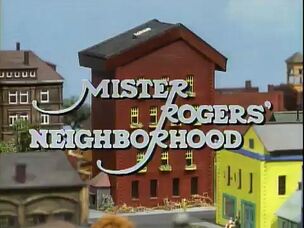
Mister Rogers' Neighborhood intro
Mister Rogers' Neighborhood is an American half-hour children's television series that was created and hosted by namesake Fred Rogers. The series originated in 1963 as Mister Rogers on CBC Television, and was later re-branded in 1966 as Mister Rogers' Neighborhood on the regional Eastern Educational Network (EEN, a forerunner of today's American Public Television), followed by its U.S. network debut on February 19, 1968, and it aired on NET and its successor, PBS, until August 31, 2001. The series is aimed primarily at preschool ages 2 to 5, but has been stated by PBS as "appropriate for all ages". Mister Rogers' Neighborhood was produced by Pittsburgh, Pennsylvania, public broadcaster WQED and Rogers' non-profit production company Family Communications, Inc. There are 912 episodes in all. While PBS's national feed originally dropped the show as of August 31, 2008, many PBS stations continue to air reruns of the show on weekends and holidays.
Format[]
During each half-hour segment, Rogers speaks directly to the viewer about various topics, taking the viewer on tours of factories, demonstrating experiments, crafts, and music, and interacting with his friends. Rogers also made a point to simply behave naturally on camera rather than acting out a character, stating that "One of the greatest gifts you can give anybody is the gift of your honest self. I also believe that kids can spot a phony a mile away." The half-hour episodes were punctuated by a puppet segment chronicling occurrences in the Neighborhood of Make-Believe. Another segment of the show consisted of Rogers going to different places around the neighborhood, where he interviews people to talk about their work and other contributions that focused on the episode's theme, such as Brockett's Bakery, Bob Trow's Workshop, and Negri's Music Shop. In one episode, Rogers took the show behind-the-scenes on the set of The Incredible Hulk, which aired on CBS from 1978 to 1982.
At the start of each episode, the show's logo appears as the camera pans slowly over a model of the neighborhood, as the camera goes from the neighborhood to inside the Rogers' television house. From 1979 to 1981, an alternate version of the opening sequence was used. Beginning in the early 1980s, the neighborhood model incorporated a small version of the "Neighborhood Trolley", as it crosses several streets from left to right on a model train track. This is the same model electric trolley that later in the program will transport viewers into the Neighborhood of Make-Believe. Usually, the camera goes from the neighborhood to out on the porch of the Rogers' television house, where the viewers see Fred Rogers coming for a visit before he enters the house. After the camera goes from the neighborhood to inside the Rogers' television house, Fred Rogers is seen coming home with his jacket on, singing "Won't You Be My Neighbor?". He goes into the closet, takes off his jacket, hangs it up, and grabs a cardigan zipper sweater to put on. After that, he takes his dress shoes off and grabs a pair of blue sneakers to put on. One of Rogers' sweaters now hangs in the Smithsonian Institution, a testament to the cultural influence of his simple daily ritual.
Cast[]
- Fred Rogers as himself
- David Newell as Mr. McFeely
- Betsy Nadia’s as Mrs. McFeely
- Betty Aberlin as Lady Aberlin
- Chuck Aber as Neighbor Aber
- Don Brockett as Chef Brockett
- Maggie Stewart as Mayor Maggie
- François Clemmons as Officer Clemmons
Funding[]
- Public Television Stations (1975-2001)
- The Corporation for Public Broadcasting (1971-1976, 1991-2001)
- Ford Foundation (1975-1976)
- The Sears-Roebuck Foundation (1968-1992)
- Johnson & Johnson Baby Products Company (1975-1976)